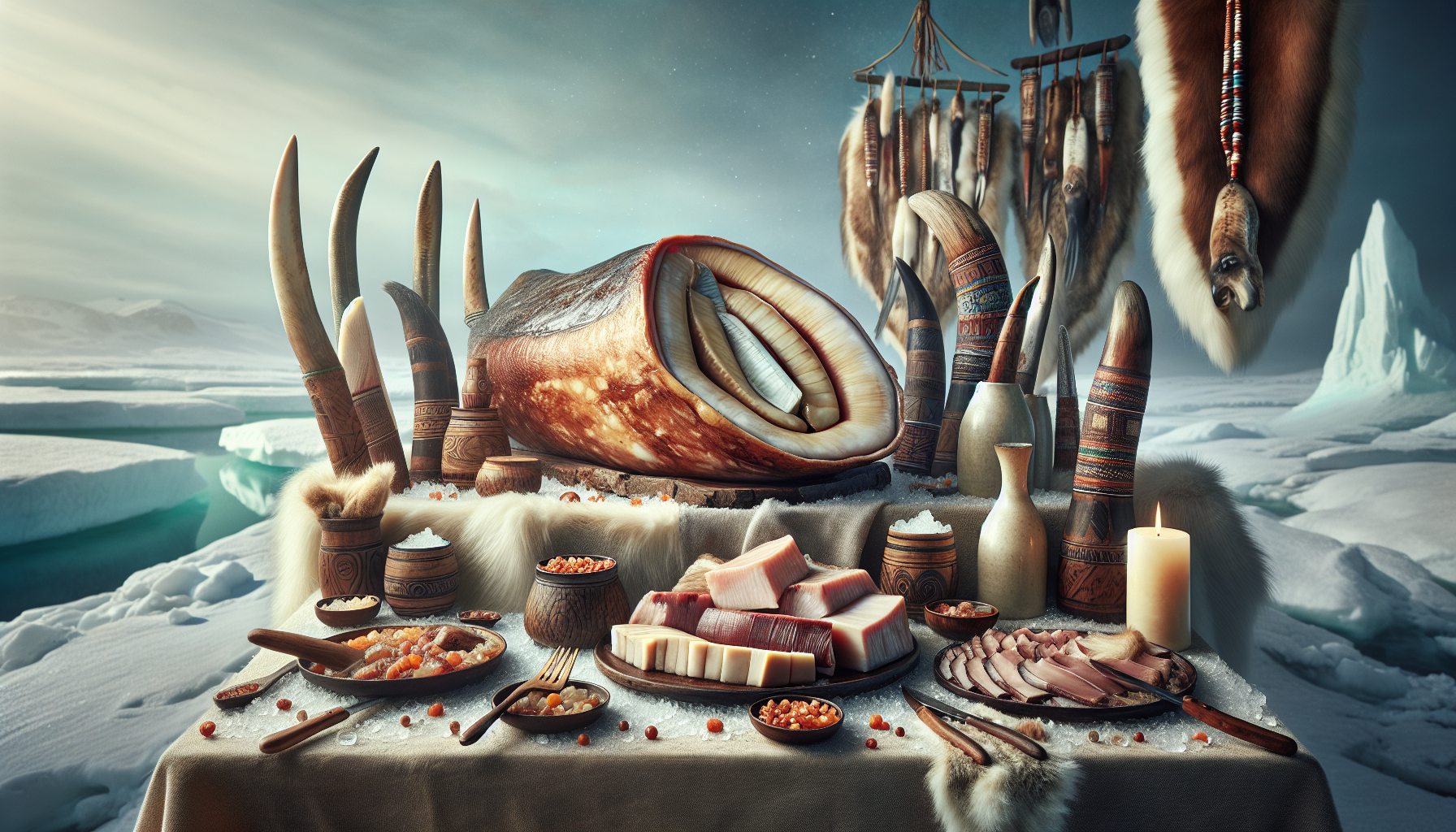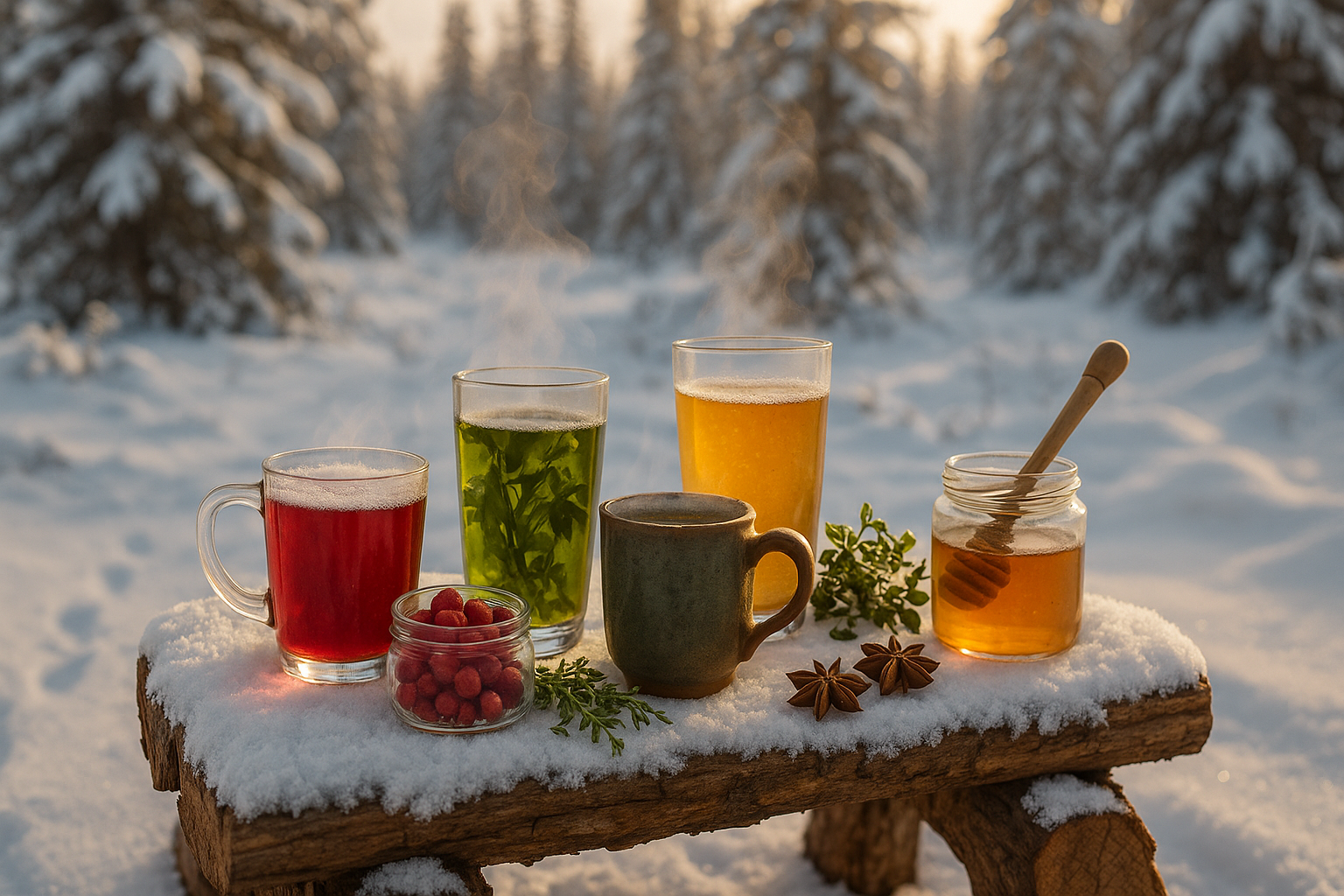In the vast, icy expanses of the Arctic, where the landscape is as breathtaking as it is unforgiving, a unique culinary tradition has thrived for centuries, woven intricately into the fabric of Inuit culture. This tradition is not just about sustenance; it’s a profound connection to the land, the sea, and the ancestors who navigated these formidable terrains. At the heart of this culinary heritage lies “muktuk,” a dish as rich in history as it is in flavor, offering a window into the soul of the Inuit people. Muktuk, typically made from the skin and blubber of whales, is more than just a meal—it’s a testament to the resilience and resourcefulness of a community living in harmony with nature’s cycles. 🌊
Join us on a journey through the fascinating world of Inuit cuisine, where every bite tells a story of survival, tradition, and respect for the natural world. In this article, we will dive deep into the origins of muktuk, exploring its preparation methods and cultural significance. We’ll delve into how the Inuit have preserved this age-old practice amidst modern challenges and what it means for their identity today. Alongside muktuk, we’ll explore other traditional foods that form the backbone of Inuit culinary practices, such as seal and caribou, and the communal rituals that surround these meals. This exploration will not only broaden your understanding of Inuit culture but also invite you to appreciate the delicate balance they maintain with their environment.
As we unwrap the layers of this extraordinary tradition, we’ll highlight the contemporary adaptations that bring Inuit cuisine to global tables without losing its authentic essence. You’ll discover how chefs and cultural ambassadors are using innovative approaches to introduce muktuk and other traditional dishes to wider audiences, celebrating Inuit heritage while fostering cross-cultural appreciation. Whether you’re a culinary adventurer eager to taste the world or someone with a keen interest in indigenous cultures, this deep dive into the delights of whale muktuk and Inuit cuisine promises to leave you inspired and enriched. So, prepare your palate and your imagination as we embark on this flavorful expedition into the heart of the Arctic. 🐋
The Cultural Significance of Muktuk in Inuit Cuisine
Whale Muktuk, an iconic element of Inuit cuisine, represents more than just a traditional dish; it is a profound connection to cultural heritage and a reflection of the Inuit way of life. For thousands of years, the Inuit people have thrived in the harsh Arctic environment, relying on the bounty of the sea for sustenance. Muktuk, made from the skin and blubber of whales, particularly bowhead, beluga, or narwhal, is not only a rich source of nutrition but also a testament to the sustainable practices and deep respect the Inuit have for nature. This dish embodies the resilience and ingenuity of a community that has honed its survival skills through generations.
The preparation of Muktuk is a meticulous process that has been passed down through families, preserving the authenticity of Inuit culinary traditions. The blubber, cut into small cubes, is often consumed raw or pickled, and it provides essential nutrients, including omega-3 fatty acids and vitamin C. These nutrients are crucial in a region where fruits and vegetables are scarce, highlighting the Inuit’s resourcefulness in utilizing available resources to meet their dietary needs. Muktuk is not merely food; it is a celebration of life and a reaffirmation of cultural identity that strengthens community bonds.
Beyond its nutritional value, Muktuk holds a ceremonial significance, often featured in festivals, gatherings, and feasts that bring communities together. The sharing of Muktuk is a gesture of goodwill and hospitality, symbolizing unity and mutual respect. The cultural rituals associated with its preparation and consumption serve as educational moments, where elders impart knowledge and traditions to younger generations. Thus, Muktuk is more than sustenance; it is an integral part of Inuit cultural expression, reflecting the harmony between humans and the environment. 🌊
Nutritional Value and Health Benefits of Muktuk
Muktuk is not only culturally significant but also nutritionally beneficial, offering a wide range of health advantages essential for survival in the Arctic. The dish is rich in omega-3 fatty acids, which are known for their cardiovascular benefits, including reducing inflammation and lowering blood pressure. These fatty acids play a crucial role in maintaining heart health, making Muktuk an important dietary component for the Inuit people, who face limited access to conventional sources of these nutrients. Additionally, Muktuk is a source of vitamin C, an essential nutrient for preventing scurvy, a common concern in environments where fresh produce is scarce.
Another significant health benefit of Muktuk is its contribution to mental health. The omega-3 fatty acids found in whale blubber have been linked to improved cognitive function and a reduced risk of depression. This aspect is particularly vital in the Arctic, where long periods of darkness can affect mental well-being. By incorporating Muktuk into their diet, the Inuit not only address physical health needs but also support emotional and psychological resilience. This multifaceted nutritional profile underscores the importance of Muktuk in sustaining the overall health of Inuit communities.
For those interested in the nutritional aspects of traditional Inuit foods, watch this informative video that delves into the health benefits of Muktuk and other indigenous ingredients. Through these insights, it becomes clear that Muktuk is more than just a cultural delicacy; it is a critical component of a balanced diet that supports both physical and mental health in the Arctic environment.
Modern Interpretations and Global Influence
As global culinary trends evolve, Muktuk has caught the attention of chefs and food enthusiasts worldwide, leading to innovative interpretations and fusion dishes that incorporate this traditional ingredient. While the authentic preparation of Muktuk remains deeply rooted in Inuit culture, modern adaptations have emerged, offering new ways to experience this unique delicacy. Chefs outside the Arctic have begun experimenting with Muktuk, integrating it into gourmet dishes that blend traditional and contemporary flavors, creating a bridge between cultures.
Incorporating Muktuk into mainstream cuisine poses both challenges and opportunities. The challenges lie in sourcing authentic, sustainably harvested whale products while respecting the cultural significance of this ingredient. However, the opportunities are vast, as introducing Muktuk to a broader audience can foster cultural appreciation and awareness of Inuit traditions. This global influence encourages a dialogue about sustainable food practices and the importance of preserving cultural heritage through cuisine.
For an example of how Muktuk is being reimagined in modern kitchens, watch this creative culinary demonstration showcasing innovative dishes that incorporate traditional Inuit ingredients. These efforts highlight the potential for Muktuk to become a celebrated component of global gastronomy, offering a taste of Arctic culture to the world.
Environmental and Ethical Considerations
The harvesting of whales for Muktuk is a practice steeped in tradition, yet it raises important environmental and ethical considerations. Sustainable hunting methods are paramount to ensure the preservation of whale populations and the ecosystems they inhabit. The Inuit have long practiced sustainable hunting, adhering to quotas and using traditional techniques that minimize environmental impact. This commitment to sustainability is essential in maintaining the balance between cultural practices and ecological responsibility.
Ethical considerations also play a significant role in the conversation around Muktuk. The use of whale products has faced scrutiny from animal rights organizations and environmental advocates, highlighting the need for a nuanced understanding of indigenous practices. It is crucial to acknowledge the cultural context and the dependence of Inuit communities on these resources for their livelihoods and cultural preservation. A respectful dialogue that incorporates diverse perspectives can lead to better policies that support both cultural rights and environmental conservation.
To learn more about the ethical and environmental aspects of Muktuk, check out this informative video that explores how traditional practices align with modern conservation efforts. Through education and understanding, it is possible to appreciate the significance of Muktuk while supporting sustainable and ethical practices.
How to Experience Muktuk
For those interested in experiencing Muktuk firsthand, opportunities exist to engage with Inuit culture through culinary tours, festivals, and cultural events. These experiences offer an authentic taste of Arctic cuisine while providing insight into the rich traditions and history of the Inuit people. Participating in these events allows for a deeper appreciation of Muktuk, beyond its culinary aspects, as attendees learn about the cultural practices and values that define Inuit life.
One way to immerse oneself in the Muktuk experience is by visiting Arctic regions where Inuit communities offer cultural exchanges and culinary demonstrations. These tours often include guided experiences that showcase traditional preparation methods, offering participants a hands-on understanding of the dish’s significance. Additionally, many cultural festivals feature Muktuk tastings, allowing visitors to sample this unique delicacy while engaging with Inuit artisans and storytellers.
For a glimpse into how Muktuk is celebrated in Inuit culture, explore this video that captures the essence of a traditional Inuit festival. Whether through travel or virtual exploration, experiencing Muktuk offers a meaningful connection to the rich heritage and enduring spirit of the Inuit people.
Comparative Table of Traditional Inuit Foods
For a broader understanding of Inuit cuisine, it is helpful to compare Muktuk with other traditional foods that hold cultural and nutritional significance.
| Food | Main Ingredient | Preparation Method | Nutritional Benefits |
|---|---|---|---|
| Muktuk | Whale blubber and skin | Raw, pickled, or frozen | Omega-3 fatty acids, Vitamin C |
| Akutaq | Animal fat, berries, fish | Mixed and whipped | High energy, essential fats |
| Qallupilluk | Seal meat | Boiled or roasted | Protein, iron |
| Pemmican | Dried meat, fat, berries | Pounded and mixed | Long-term energy, nutrients |
Each of these foods reflects the Inuit’s ability to adapt to their environment and make the most of available resources, offering a rich tapestry of flavors and nutritional benefits. By exploring these traditional dishes, one gains a deeper understanding of the interconnectedness of culture, environment, and sustenance in Inuit life.

Conclusion
Experiencing the rich tradition of Inuit cuisine through dishes like Whale Muktuk provides not only a culinary adventure but also a profound insight into the culture and lifestyle of the Inuit people. Throughout this article, we’ve explored the historical significance, nutritional value, and cultural importance of this traditional dish, which serves as a testament to the ingenuity and resilience of the Inuit communities.
The journey began with an exploration of the historical context of Muktuk, a dish made primarily from the skin and blubber of whales, and its critical role in Inuit society. This delicacy is more than just sustenance; it is a symbol of survival, community, and respect for the environment. For centuries, the Inuit have relied on the ocean and its offerings, developing a sustainable way of living that honors the balance between nature and human needs. The preparation and sharing of Muktuk reflect a deep-seated tradition that emphasizes communal living and respect for the resources that sustain life.
Nutritionally, Whale Muktuk is rich in essential vitamins and nutrients, such as vitamin C and omega-3 fatty acids, which are crucial for health, especially in the harsh Arctic climate. This dish not only fulfills dietary needs but also exemplifies how traditional diets can be inherently balanced and nourishing. The Inuit diet, centered around marine life, showcases a model of eating that is both ecologically sustainable and health-conscious, offering valuable lessons for contemporary discussions on food security and environmental responsibility.
Culturally, the preparation and consumption of Muktuk are acts deeply embedded with meaning. Sharing Muktuk is often part of larger community gatherings and celebrations, strengthening social bonds and preserving cultural heritage. The dish is a conduit for storytelling and the transmission of knowledge from one generation to the next, making it a living piece of history. Through the lens of Inuit cuisine, we can appreciate the importance of food as a cultural artifact that carries with it the stories and values of a people.
In today’s world, where globalization often threatens the preservation of indigenous traditions, it is imperative to recognize and support the richness of Inuit culinary practices. By engaging with and respecting these traditions, we contribute to a broader understanding and appreciation of cultural diversity. Celebrating dishes like Whale Muktuk not only honors the past but also ensures that these valuable traditions continue to thrive in the future.
To truly embrace the experience of Inuit cuisine, one might consider participating in cultural exchanges or culinary experiences that offer authentic presentations of Muktuk. Such engagement not only broadens one’s palate but also deepens one’s appreciation for the intricate relationship between food, culture, and identity.
As we conclude, it’s essential to reflect on the broader implications of learning about and engaging with indigenous cuisines. This exploration invites us to consider our own food choices and the stories they tell about who we are and where we come from. It encourages us to think critically about sustainability, respect for nature, and the importance of preserving cultural heritage in a rapidly changing world.
We encourage you to share this newfound knowledge with others, sparking conversations that can lead to greater understanding and appreciation of indigenous cultures. Comment below to share your thoughts and experiences, or spread the word by sharing this article with friends and family. Let this be an invitation to explore, learn, and celebrate the rich tapestry of human culture through the universal language of food. 🌍
For further exploration into the world of Inuit cuisine and the cultural significance of dishes like Whale Muktuk, consider visiting resources such as the and the . These platforms provide invaluable insights into the traditions and lives of Inuit communities, fostering a deeper connection and understanding.
By embracing and promoting such traditions, we not only preserve the past but also enrich our collective future, celebrating the diversity that makes our world a more vibrant place to live. 🍽️





